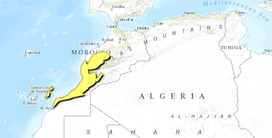| Mediterranean Acacia-Argania dry woodlands and succulent thickets | |
|---|---|
 Argan tree, which is dominant in these woodlands Argan tree, which is dominant in these woodlands | |
 location of the ecoregion location of the ecoregion | |
| Ecology | |
| Realm | Palearctic |
| Biome | Mediterranean forests, woodlands, and scrub |
| Borders | |
| Geography | |
| Area | 99,619 km (38,463 sq mi) |
| Countries | |
| Autonomous community of Spain | Canary Islands |
| Conservation | |
| Conservation status | Critical/endangered |
| Protected | 17,725 km (18%) |
The Mediterranean Acacia–Argania dry woodlands and succulent thickets is a Mediterranean forests, woodlands, and scrub ecoregion in North Africa centered mainly on Morocco but also including northwestern Western Sahara and the eastern Canary Islands.
Geography
This ecoregion occupies 1,000,000 km (390,000 sq mi) in Morocco, northwestern Western Sahara, and the eastern Canary Islands (Lanzarote, Fuerteventura, and associated islets). On the African mainland, it encompasses the Atlantic coastal plain, the lowlands of Al Haouz Province, the valleys of the Sous River and Draa River, and the westernmost part of the High Atlas and Anti-Atlas Mountains.
It has either a Mediterranean climate or a semi-arid climate or even an arid climate given that mean annual rainfall is below 500 millimetres (20 in) and falls as low as 50 millimetres (2.0 in) in the driest areas of the ecoregion. The winters are mild and frost-free and the summers relatively cool because of the moderating influence of the ocean. Temperatures average 18 to 20 °C (64 to 68 °F).
The Mediterranean Acacia-Argania dry woodlands and succulent thickets ecoregion is bounded on the north by the Mediterranean woodlands and forests, on the east by the North Saharan steppe and woodlands, on the south by the Atlantic coastal desert, and on the west by the Atlantic Ocean.
Flora
The chief plant communities in the ecoregion are dominated by Argania spinosa, Olea europaea, Balanites aegyptiaca, Cupressus sempervirens, Vachellia tortilis, Phoenix canariensis, Phoenix dactylifera, Salix alba, Juglans regia, Populus nigra, Quercus coccifera, Quercus rotundifolia, Quercus ilex, Quercus pubescens, Quercus suber, Pinus nigra, Pinus pinaster, Pinus pinea, Pinus halepensis, Ceratonia siliqua, Arbutus unedo, Erica arborea, Juglans regia, Laurus nobilis, Vachellia flava, Senegalia senegal, Prosopis cineraria, Aerva javanica, Prunus amygdalus, Ziziphus spina-christi, Pistacia atlantica, Pistacia terebinthus, Juniperus communis, Prunus padus, Quercus robur, Quercus petraea, Picea abies, Abies alba, Alnus glutinosa, Fagus sylvatica, Taxus baccata, Acer pseudoplatanus, Malus sylvestris, Viburnum lantana, Fraxinus excelsior, Tilia cordata, Aesculus hippocastanum, Rhamnus cathartica, Ulmus glabra, Ulmus minor, Populus alba, Populus tremula, Pinus sylvestris, Betula pendula, and Corylus avellana, accompanied by Acacias, and the predominant lower vegetation is succulent shrubland dominated by Euphorbias. Some of the associated plant species are Periploca laevigata, Senecio anthephorbium, Launaea arborescens, Warionia saharae, Acacia gummifera, Rhus trpartitum, Withania frutescens, Euphorbia officinarum, Cytisus albidus, Ephedra altissima and Tetraclinis articulata.
There are a number of plants endemic to the Canary Islands portion of the ecoregion.
Fauna
Mammals found on the mainland portion of the ecoregion include the honey badger, European wildcat, Egyptian mongoose, Barbary ground squirrel, North African elephant shrew, Hoogstraal's gerbil, Barbary striped grass mouse and wild boar. Other, rarer mammals include caracal, African wildcat, dorcas gazelle, Cuvier's gazelle and Barbary sheep. The Canarian shrew (Crocidura canariensis) is endemic to Fuerteventura, Lanzarote, and neighboring islets.
Protected areas
A 2017 assessment found that 17,725 km, or 18%, of the ecoregion is in protected areas. Protected areas in Morocco include Arganeraie Biosphere Reserve (23690 km, Souss-Massa National Park), Khenifiss National Park (1668.16 km), Oued Chbeyka Hunting Reserve (1329.78 km), and Rouisset Tayssa Boulafraij Ouinskour et Oued Daraa Hunting Reserve (3177.54 km).
Protected areas in the eastern Canary Islands include Timanfaya National Park (51.81 km), Chinijo Archipelago Natural Park (460.16 km), and Los Volcanes Natural Park (99.95 km) on Lanzarote, and Jandia Natural Park (149.83 km) and Corralejo Natural Park (26.89 km) on Fuerteventura.
External links
- "Mediterranean Acacia-Argania dry woodlands and succulent thickets". Terrestrial Ecoregions. World Wildlife Fund.
References
- ^ "Mediterranean Acacia-Argania dry woodlands and succulent thickets, in Northern Africa". Terrestrial Ecoregions. World Wildlife Fund. Retrieved 25 November 2016.
- ^ Eric Dinerstein, David Olson, et al. (2017). An Ecoregion-Based Approach to Protecting Half the Terrestrial Realm, BioScience, Volume 67, Issue 6, June 2017, Pages 534–545; Supplemental material 2 table S1b.